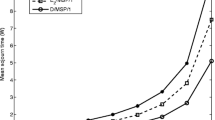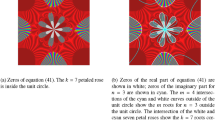Abstract
A stationary queueing system is described in which a single server handles several competing Poisson arrival streams on a first-come first-served basis. Each class has its own generally distributed service time characteristics. The principal result is the Laplace-Stieltjes transform, for each class, of the interdeparture time distribution function. Examples are given and applications are discussed.
Similar content being viewed by others
References
G. Bitran and D. Tirupati, Multiproduct queueing networks with deterministic routing: decomposition approach and the notion of interference, Man. Sci. 34 (1988) 75–100.
P.J. Burke, The output of a queueing system, Operations Research 4 (1956) 699–704.
R.W. Conway, W. Maxwell and L. Miller,Theory of Scheduling (Addison-Wesley, Reading, Mass. 1967).
D.J. Daley, Queueing output processes, Adv. Appl. Prob. 8 (1976) 395–415.
D. Gross, C.M. Harris,Fundamentals of Queueing Theory (Wiley, New York, 1974).
L. Kleinrock,Queueing Systems, Vol. I: Theory (Wiley, New York, 1975).
P.J. Kuehn, Approximate analysis of general queueing networks by decomposition, IEEE Transactions on Communications, COM-27 (1979) 113–126.
K.T. Marshall, Some inequalities in queuing, Operations Research, 16 (1968) 651–665.
P. Nain, Interdeparture times from a queueing system with preemptive resume priority, Performance Evaluation 4 (1984) 93–98.
M. Segal and W. Whitt, A Queueing network analyzer for manufacturing, Proc. 12th Int'l. Teletraffic Congress, Turin, Italy, June 1988.
D.A. Stanford, Modelling priority queueing characteristics in approximate analytical tools for open queueing networks, in:Modelling Techniques and Tools for Performance Analysis (Elsevier-North-Holland, 1986) pp. 131–143.
L. Takács,Introduction to the Theory of Queues (Oxford University Press, 1962).
W. Whitt, The queueing network analyzer, Bell System Technical Journal 62, No. 9 (1983) 1779–2815.
W. Whitt, Approximations for departure processes and queues in series, Nav. Res. Log. Qtrly. 31 (1984) 499–521.
W. Whitt, A light traffic approximation for single-class departure processes from multi-class queues, Man. Sci. 34 (1988) 1333–1346.
Author information
Authors and Affiliations
Rights and permissions
About this article
Cite this article
Stanford, D., Fischer, W. The interdeparture-time distribution for each class in the ∑ i M i /G i /1 queue. Queueing Syst 4, 179–191 (1989). https://doi.org/10.1007/BF02100265
Received:
Revised:
Issue Date:
DOI: https://doi.org/10.1007/BF02100265




